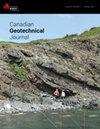软土地基改良虹吸-真空排水系统真空形成的理论与现场研究
IF 3.5
3区 工程技术
Q2 ENGINEERING, GEOLOGICAL
引用次数: 0
摘要
与传统的软土地基整治排水固结措施相比,虹吸-真空排水法(SVD)具有排水效率提高、维护成本降低、能源和材料需求减少、环境影响小等优点。因此,有望在软土地基改造中得到广泛应用。然而,真空在该系统中形成的机制尚不清楚。本文通过对虹吸排水和渗流过程中水位和气压变化的理论推导,探讨了SVD的真空形成机理。建立了一个理论模型来描述真空的形成,从而可以估计系统中不同的空气压力、水位、渗流率和排放率。并在浙江舟山进行了实地调查,进一步验证了所建立模型的正确性。本工作也为SVD在软土地基改良中的现场应用提供了进一步的见解和建议。本文章由计算机程序翻译,如有差异,请以英文原文为准。
Theoretical and field investigation into the vacuum formation in the siphon-vacuum drainage system for soft ground improvement
Compared to the traditional drainage consolidation measures for soft ground improvement, the siphon-vacuum drainage method (SVD) offers more advantages, e.g., improved drainage efficiency, lower maintenance costs, lower demand for energy and materials, and less environmental impact. Hence, it is expected to be widely applied in soft ground improvement. However, the mechanism of vacuum formation in the system remains unclear. In this work, the vacuum formation mechanism of SVD is investigated based on the theoretical deduction of the variations of the water level and air pressures during the siphon drainage and seepage processes. A theoretical model is developed to describe the vacuum formation, allowing the estimation of the varying air pressure, water level, seepage rate, and discharge rate in the system. Moreover, a field investigation was carried out in Zhoushan, Zhejiang Province, to further validate the correctness of the developed model. This work also provides further insights and suggestions into the field application of SVD for soft ground improvement.
求助全文
通过发布文献求助,成功后即可免费获取论文全文。
去求助
来源期刊

Canadian Geotechnical Journal
地学-地球科学综合
CiteScore
7.20
自引率
5.60%
发文量
163
审稿时长
7.5 months
期刊介绍:
The Canadian Geotechnical Journal features articles, notes, reviews, and discussions related to new developments in geotechnical and geoenvironmental engineering, and applied sciences. The topics of papers written by researchers and engineers/scientists active in industry include soil and rock mechanics, material properties and fundamental behaviour, site characterization, foundations, excavations, tunnels, dams and embankments, slopes, landslides, geological and rock engineering, ground improvement, hydrogeology and contaminant hydrogeology, geochemistry, waste management, geosynthetics, offshore engineering, ice, frozen ground and northern engineering, risk and reliability applications, and physical and numerical modelling.
Contributions that have practical relevance are preferred, including case records. Purely theoretical contributions are not generally published unless they are on a topic of special interest (like unsaturated soil mechanics or cold regions geotechnics) or they have direct practical value.
 求助内容:
求助内容: 应助结果提醒方式:
应助结果提醒方式:


